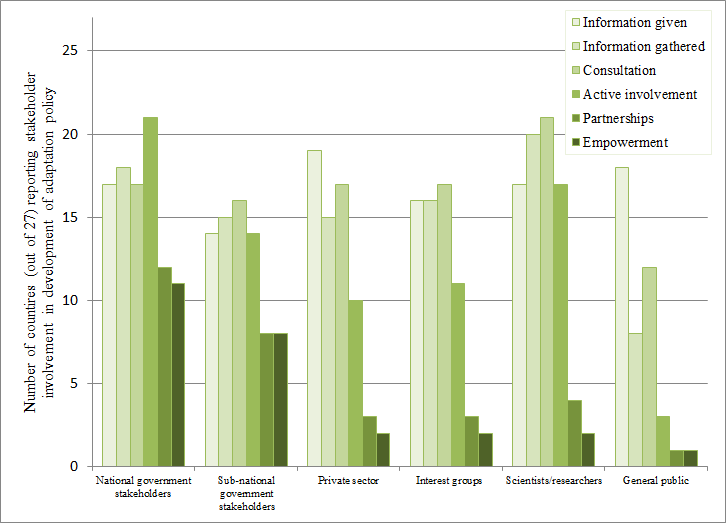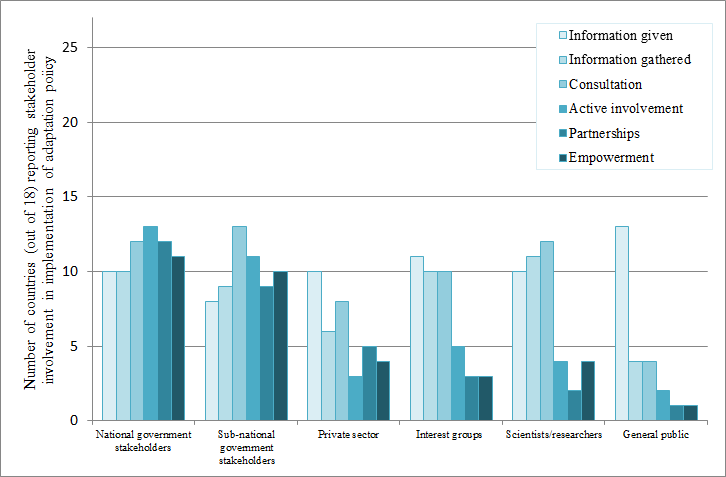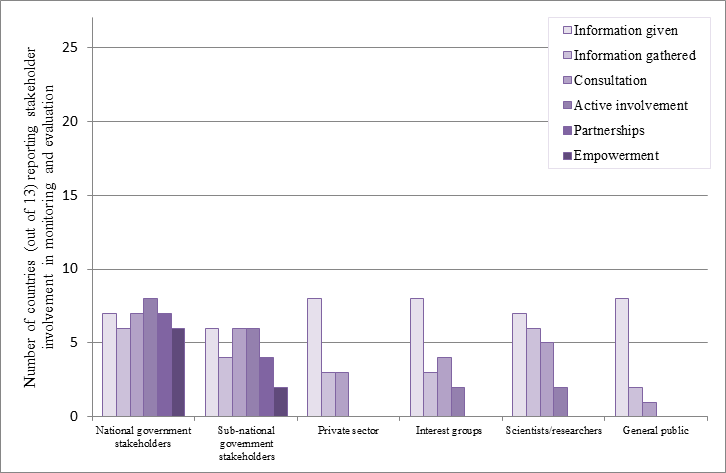Table of contents
- Acknowledgements
- Executive summary
- Objectives, intended users and context of this report
- Outline of this report
- Methodological approach
- Lessons learned from collaborating with member countries through the self-assessment survey
- 1. Rationale for public intervention on adaptation
- 2.1. Key Topic 1: Public and policy awareness of the need for adaptation
- 2.1.1. Awareness of the need for adaptation: what does this include?
- 2.1.2. Findings from self-assessment survey
- 2.1.3. Examples from countries
- 2.1.4. Discussion of findings
- 2.2. Key Topic 2: Knowledge generation and use
- 2.2.1. Knowledge generation and use: what does this include?
- 2.2.2. Findings from self-assessment survey
- 2.2.3. Examples from countries
- 2.2.4. Discussion of findings
- 2.3. Key Topic 3: Planning adaptation
- 2.3.1. Planning adaptation: what does this include?
- 2.3.2. Findings from self-assessment survey
- 2.3.3. Examples from countries
- 2.3.4. Discussion of findings
- 2.4. Key Topic 4: Coordination of adaptation
- 2.4.1. Coordination of adaptation: what does this include?
- 2.4.2. Findings from self-assessment survey
- 2.4.3. Examples from countries
- 2.4.4. Discussion of findings
- 2.5. Key Topic 5: Stakeholder involvement
- 2.5.1. Stakeholder involvement: what does this include?
- 2.5.2. Findings from self-assessment survey
- 2.5.3. Examples from countries
- 2.5.4. Discussion of findings
- 2.6. Key Topic 6: Implementation of adaptation
- 2.6.1. Implementation of adaptation: what does this include?
- 2.6.2. Findings from self-assessment survey
- 2.6.3. Examples from countries
- 2.6.4. Discussion of findings
- 2.7. Key Topic 7: Transnational cooperation
- 2.7.1. Transnational cooperation: what does this include?
- 2.7.2. Findings from self-assessment survey
- 2.7.3. Examples from countries
- 2.7.4. Discussion of findings
- 2.8. Key Topic 8: Monitoring, reporting and evaluation
- 2.8.1. Monitoring, reporting and evaluation (MRE): what does this include?
- 2.8.2. Findings from the self-assessment survey
- 2.8.3. Examples from countries
- 2.8.4. Discussion of findings
- 3. The evolving agenda for national adaptation in Europe
- 4. Glossary
- 5. Acronyms
- 6. References
2.5.2. Findings from self-assessment survey
The self-assessment survey requested information on four questions on stakeholder involvement: the general contribution of stakeholders’ involvement in the adaptation policy process, the stakeholders involved and the format of their involvement in the development, implementation and monitoring and evaluation phases of the adaptation process, and elements of successful stakeholder processes. Information on formats of stakeholder involvement has been cross-checked with the responses to an additional question on the stage of the adaptation policy process.
| Question from self-assessment survey (including the question number) | Number of countries answering this question (including % on total number) |
|---|---|
| Have you involved stakeholders in the adaptation policy process? (Q38) | 28/30 (93 %) |
| If yes, how would you assess the general contribution of stakeholders/actors engagement in the adaptation policy process? (Q39) | 28/30 (93 %) |
| The three tables below allow you to identify the stakeholders involved and the format of their involvement for the development (1st table), implementation (2nd table) and monitoring and evaluation (3rd table) phases of the adaptation process. (Q40) | 1st table: 27/30 (90%) 2nd table: 18/30 (60%) 3rd table: 13/30 (43%) |
| From your experience, what are the three most important elements in running a successful stakeholder process? (Q41) | 23/30 (77%) |
| Please give a short description of the horizontal and vertical coordination of adaptation policy in your country. Please also indicate who has been involved and what mechanism for coordination has been used (please also indicate if these mechanisms have changed in the different stages of the process, e.g. from formulation to implementation). Sub-question: What was challenging or missing? (Q15) | 19/29 (66%) |
Stakeholder involvement in adaptation policy processes has been used throughout Europe and its importance is recognised by all responding countries
All of the 28 responding countries reported involving stakeholders in their adaptation policy processes at some level. Nearly half of the countries (13/28) assessed the contribution of stakeholders as very important and another 13 countries described it as important. Two countries expressed a neutral view on the general contribution of stakeholders in the adaptation policy process.
The form of stakeholder involvement varies with stakeholder groups and stage of the adaptation policy process. Responses from the countries show that who have been involved and how has changed with the stages of the policy process from policy development to policy implementation and finally monitoring and evaluation of adaptation policies.
Provision of information is used throughout the policy processes for practically all stakeholder groups. In the development and implementation phases, information has also been gathered extensively from different stakeholder groups and consultations have been used for most stakeholder groups except for the general public. In the implementation and monitoring and evaluation stages, anything beyond consultation is relatively rare. Few countries report active involvement, partnerships or empowerment in any stage for stakeholders outside national and sub-national levels of government (Figure 2.13, Figure 2.14, Figure 2.15). Those that do, report slightly more empowerment of private sector and scientific community stakeholders in the implementation than in the development of policies.
More and deeper involvement is reported in development of adaptation policy than in implementation or monitoring and evaluation of policies
Countries have reported more and deeper stakeholder involvement in adaptation policy development compared to other stages of the adaptation policy process. The greatest number of responses was also provided on involvement in policy development (27 countries) followed by implementation (18) and monitoring and evaluation (13). This reflects the number of countries that have progressed to the respective stages in the adaptation policy process. Overall the responses indicate a relative decline in the level of stakeholder involvement from policy development to policy implementation.
For policy development, the two most commonly reported forms of involvement (21 out of 27 responses) were active involvement of national level government stakeholders and consultation of scientists and researchers (Figure 2.13). Information has been provided to and collected from all stakeholder groups by approximately half of the countries.
For the implementation stage, the highest overall levels of involvement have been reported for government stakeholders at national and sub-national levels. For these groups, active involvement and other deeper forms of involvement were reported by approximately half of the responding countries. Non-governmental stakeholders were involved by on average half of the countries, primarily in information sharing and consultation. Involvement of the general public in implementation was mostly reported as being limited to dissemination of information (Figure 2.14).
The monitoring and evaluation stage has so far included relatively limited stakeholder participation. Of the 13 responding countries, highest levels and forms of involvement were reported for government stakeholders as in the other stages. Involvement of other stakeholder groups was limited to mainly information sharing and consultation, with slightly more involvement of scientists and researchers. Active involvement and other deeper forms of involvement outside national government stakeholders were reported by less than a quarter of the responding countries (Figure 2.15).
Government stakeholders at national and sub-national levels feature most visibly in involvement processes
Government stakeholders at the national level feature visibly in all forms of involvement across all stages of the adaptation policy process. The responses suggest further that approximately a third of all countries have developed and implemented their adaptation policies with rather limited involvement even at the national level (Figure 2.13, Figure 2.14, Figure 2.15). In monitoring and evaluation approximately half of the 13 responses reported national governmental stakeholder involvement (Figure 2.15).
Figure 2.13: Different forms of stakeholder involvement reported by countries in the development of their national adaptation policy (n=27)

Figure 2.14: Different forms of stakeholder involvement reported by countries in the implementation of their national adaptation policy (n=18)

Figure 2.15: Different forms of stakeholder involvement reported by countries in monitoring and evaluation of their national adaptation policy (n=13)

The involvement of sub-national governmental stakeholders has been lower than for national level stakeholders, especially in the policy development and evaluation stages (Figure 2.13, Figure 2.14, Figure 2.15). In the implementation stage approximately half of the 18 responding countries have involved sub-national government stakeholders in some way, including deep forms of involvement such as partnerships and empowerment (Figure 2.14). Overall, the relative share of deeper forms of involvement among governmental stakeholders was reported to increase from policy development to policy implementation.
Relative to governmental stakeholders, the responses to indicated lower levels of involvement for non-governmental stakeholder groups. According to the self-assessment survey, the private sector and interest groups have been treated similarly across all stages of the policy process relative to other stakeholder groups. The main focus of their involvement has been on information exchange and consultation, but more active forms of involvement have also been reported. For example in policy development, 10 and 11 countries (out of 27) have reported active involvement of the private sector and interest groups, respectively. Also in monitoring and evaluation of adaptation policies, countries have reported the involvement of interest groups to be slightly more active relative to the private sector. The implementation stage has offered some opportunities for involvement of the private sector and interest groups, but deeper forms of involvement have been used in less than a fifth of the responding countries (Figure 2.14).
For scientists and researchers, the most commonly reported form of involvement in development and implementation of adaptation policies has been consultation. In the implementation stage, 12 out of 18 countries reported consultation as one of the forms of involvement used with scientific community stakeholders. The scientific community has also been an important provider of information and at least half of the counties have reported that information has been actively gathered from the research community in all stages of the policy process.
According to the responses, information on adaptation has been provided to the general public in all stages of adaptation policy. In the policy development stage some countries have reported that information has been gathered from the general public. In later stages virtually no countries use other levels of involvement for the general public.
Countries emphasize the importance of transparent, inclusive and well-informed stakeholder involvement processes
Countries have highlighted a number of ways by which the chances of successful stakeholder involvement can be increased. The factors that countries have identified as contributing to successful involvement can be grouped into those that contribute to a strong basis for involvement, those that ensure functioning involvement processes, and those ensuring that appropriate stakeholders get involved (Table 2.10).
The strengthening of the base for involvement that countries have reported can be seen to aim at ensuring informed discussions on adaptation to climate change. This can be facilitated e.g. by supporting stakeholders’ capacities for involvement and ensuring knowledge provision to involvement processes.
With respect to the involvement process itself, countries have emphasised characteristics such as early involvement, dialogue, transparency and continuity (Table 2.10). Motivating stakeholders to participate and ensuring continued commitment among stakeholders beyond one-off meetings were reported as success factors by countries. Importantly, difficulties related to motivating stakeholders and raising the will to act on adaptation were reported by countries as challenges in relation to coordination mechanisms and processes.
Countries have noted the importance of differentiating between stakeholders. Consequently, countries considered that clear definition of the roles, responsibilities and scopes of influence for different stakeholder groups are essential preconditions for running a successful stakeholder involvement process. Sensitivity to different stakeholders also implies the use of appropriate language and providing information in an accessible and easily understandable format, which links back to planning of involvement processes. Selection of methods appropriate for each stakeholder group and clarity in the objectives of the involvement process are key to ensuring successful stakeholder processes.
Table 2.10 Reported examples of success factors for stakeholder involvement
| Success factor | Examples of country responses | Countries | |
|---|---|---|---|
| Basis for involvement | |||
| Awareness raising |
“raising importance of climate change and adaptation in the eyes of all stakeholders“ |
BG, DK, LI, LV, PT | |
| Providing knowledge |
“communication of scientific results” |
AT, DE, IT, LI, MT | |
| Capacity building |
“capacity building” |
FR, PT | |
| Characteristics of involvement process | |||
| Involvement early in the process |
“early involvement into the policy process” |
AT, DK, FR, IT, LV | |
| Two way communication |
“good communication” |
AT, BE, CZ, DK, RO | |
| Methods of involvement |
“system approach” |
CZ, DE, FI | |
| Transparency of process |
“transparent and effective protocols” |
AT, ES, FI, RO, SI | |
| Continuity of processes |
“follow-up process” |
DK, ES | |
| Range and role of involved stakeholders | |||
| Selection of stakeholders |
“engage right stakeholders” |
CH, FI, MT, UK | |
| Involving a wide range of stakeholders |
“active engagement from all stakeholders” |
CZ, DE, IT, LV, SI, SK | |
| Definition of roles and responsibilities |
“defining responsibilities” |
AT, CZ, LI | |
Note: for country codes, please check Table 2.5


